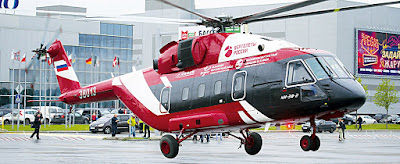At the HeliRussia 2016 show on 19-21 May 2016, Russian Helicopters holding company announced that the Russian Defence Ministry would be launch customer for the Mil Mi-38 advanced multirole helicopter. "The Russian Defence Ministry, in conjunction with Russian Helicopters, has decided on the procedure for and schedule of the acquisition of Mi-38 helicopters for the Russian Air Force. The feasibility of including the aircraft into the next armament programme's draft is being considered," the manufacturer said in a press release. "The decision provides for the joint flight tests of the new version of the Mi-38 medium multirole helicopter equipped to meet the requirements of the Defence Ministry and made of Russian-manufactured parts and components only. The advanced helicopter will take a number of flight tests for compliance with the military's requirement. Its acquisition will be planned based on the results it produces in the trials."
Kazan Helicopters is expected to build the first two Mi-38s for the Defence Ministry in 2017.
As is known, the Mi-38-2 transport version powered by Russian-made Klimov TV7-117V engines and equipped with the Russian-made VR-382 main gearbox, TA14-038 auxiliary power unit and IBKO-38 avionics suite was certificated by Russian aviation authorities late last year, with its type certificate issued on 30 December 2015. According to the Mil Helicopter Plant's 2015 annual report, so far the transport version of the Mi-38-2 is certificated for flight at a maximum speed of 250 km/h with a maximum takeoff weight of 14,200 kg and with a maximum lifting capacity of 4,200 kg. The helicopter's operational envelope is to be expanded, the restrictions are to be lifted gradually and it is to be certificated in line with its design characteristics (maximum takeoff weight 15,600 kg, that with underslung cargo - 16,200 kg, lifting capacity 6,000 kg in the cabin and 7,000 kg underslung, maximum cruising speed 285 km/h), including its passenger version, in 2016 through 2018.
The third flying prototype of the Mi-38, OP-3, was on display in front of the entrance to the pavilion at HeliRussia 2016. It had taken part in the certification trials along with the fourth prototype, OP-4. The two aircraft logged 215 test flights - a total of 210 flight hours - under the flight test programme in 2015.
The Klimov TV7-117V engine with a takeoff power of 2,500 hp (emergency power rating - 3,750 hp) was certificated in Russia on 29 July 2015. Then, on 8 October 2015, the aviation authority cleared the main design modification - the transition to the second service life control strategy allowing an assigned life of 1,400 h for the engine.
 |
| Mil Mi-38 |
Kazan Helicopters is expected to build the first two Mi-38s for the Defence Ministry in 2017.
As is known, the Mi-38-2 transport version powered by Russian-made Klimov TV7-117V engines and equipped with the Russian-made VR-382 main gearbox, TA14-038 auxiliary power unit and IBKO-38 avionics suite was certificated by Russian aviation authorities late last year, with its type certificate issued on 30 December 2015. According to the Mil Helicopter Plant's 2015 annual report, so far the transport version of the Mi-38-2 is certificated for flight at a maximum speed of 250 km/h with a maximum takeoff weight of 14,200 kg and with a maximum lifting capacity of 4,200 kg. The helicopter's operational envelope is to be expanded, the restrictions are to be lifted gradually and it is to be certificated in line with its design characteristics (maximum takeoff weight 15,600 kg, that with underslung cargo - 16,200 kg, lifting capacity 6,000 kg in the cabin and 7,000 kg underslung, maximum cruising speed 285 km/h), including its passenger version, in 2016 through 2018.
The third flying prototype of the Mi-38, OP-3, was on display in front of the entrance to the pavilion at HeliRussia 2016. It had taken part in the certification trials along with the fourth prototype, OP-4. The two aircraft logged 215 test flights - a total of 210 flight hours - under the flight test programme in 2015.
The Klimov TV7-117V engine with a takeoff power of 2,500 hp (emergency power rating - 3,750 hp) was certificated in Russia on 29 July 2015. Then, on 8 October 2015, the aviation authority cleared the main design modification - the transition to the second service life control strategy allowing an assigned life of 1,400 h for the engine.




No comments:
Post a Comment